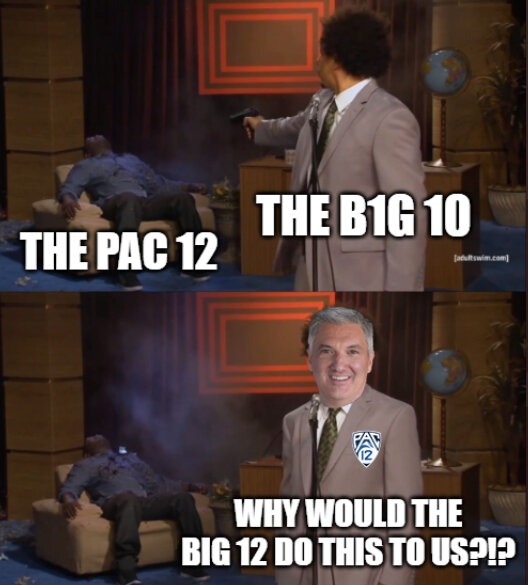Football ...
Basketball ...
Baseball ...
Other Sports ...
Futbol ...
🤫995🤫 ...
Gambling ...
Movies & TV ...
Music ...
Hobbies ...
Lulz ...
Food & Travel
...
Daily Texan ...
Business & Markets ...
Cloak Room ...
Help ...
For Sale ...
Board Discussion ...
Advertise...
Tailgate Donations
-
Posts
2294 -
Joined
-
Last visited
Content Type
Profiles
Forums
Store
Downloads
Recruiting - 2020
2019-2020 Football Season
Football
Entertainment
Sports
News and Business
Cloak Room
Transfer Portal
Recruiting
Events
Everything posted by Hurtlocker
-
They're not alone:
-
it's not that they "bring" it, it's that they reside within it
-
Big Ten Hopes to Earn at Least $1.5B Annually in Media Rights Deal
-
Its the CFP. Right now its all FBS conferences getting some say but the P5 have the most. They'll still have multiple conferences involved to avoid anti-trust issues, but whoever is left standing of the P5 will call the shots.
-
I'll play! Assuming the Big Ten doesn't take Stanford, Oregon, and Washington to pair with ND... Based off "reports" the current Big 12, without a linear channel, is worth about 15-20% more than the Pac10 is, give or take and that's primarily driven by Oregon and Washington. They're not really worth enough to add to the Big Ten's average, but they're now 40-50% of the Pac's current value. 1) Oregon. They are the biggest current brand remaining in the Pac 12. The Big 12 needs brands. They're likely valued at 40% higher than the B12 average. Downside is they're in a small DMA south of Portland. That makes them less loved by the Big Ten. 2) Washington. A bit smaller brand than Oregon, but a much higher footprint. If a linear channel is in the works they're worth more. I'd give them B12*1.4 too 3) Cal OR Stanford. Neither move the needle really. Stanford has the Ivy clout, but Cal is a major academic institution. The Big 12 probably has a better chance with Cal over Stanford, but, at the end of the day they're the same. Without a linear channel they're worth the same as Big 12 schools, with one, however, you get a top ten market, which is worth a ton. B12*20% for one, take two and its a wash. 4) ASU. They're bigger, they have over 300,000 alumni in Arizona, and they actually reside within the Phoenix DMA. This is a B12*15% and could grow depending on linear. 5) Colorado. You had them, you loved them, they broke your heart, but Denver is Denver. B12 *10% 6) Arizona likely gets the nod over Utah for this spot only because Arizona has more people and BYU is in the SLC DMA already. If you went to 18 with that line up you get a net growth for the Pac 12 schools of +30% per school revenue from current and for the Big 12 schools you're at about a >15ish% increase. What this doesn't factor in though is if you build out a Big 12 Network with someone. It wasn't worth doing it before because you had 7m households and no content to put on it. Now you'd have 22m homes and have the following states: California (1), Texas (2), Florida (4), Ohio (7), Washington (13), Arizona (14), and Colorado (21). Its not going to be BTN or SECN, but there is a lot of untapped value there and now you have a glut of inventory to do it.
-
It was: 12 at 8 conference games Lost four Gained 2 Moved from 8 conference games to 9 If you look at the games per year, Texas and Oklahoma have the most ABC/Fox games, and that was true at the time realignment started too. So, the lack of 3 games wasn't going to kill the conference value as long as they kept the core. Missouri or WVU or Colorado or ISU, etc are washes, so those extra T1 games not involving Texas and Oklahoma would draw about the same with the old members or the new. I'm pretty sure the buyouts flowed out evenly, but it wasn't that much at the time. I think Missouri got out for one year of revenue, Nebraska's was only $9m. Texas and Oklahoma will pay more in buyouts alone than all the schools that exited prior due to the change in the bylaws. The Grant of Rights was new because they weren't getting any new contract without stability. The ACC went through this a few years after the Big 12 and the Pac is going through this now. Unless the ten lock themselves together contractually, their values will plummet or they will get a deal that rewrites with any movement. Less risk for the networks means higher returns for the conference.
-
It actually works pretty well for all involved: Fox gets the first pick and Big Noon becomes their go-to slot to market to continue to erode share away from ESPN and CGD. Also ESPN used to pimp the Big Ten at the noon slot, now that would be all Fox. NBC gets the second pic for prime, which is fine with them because their top pick is putting ND on all the time at 3:30 CBS would pick third and may be ok with that if they're offering the same amount of money they pitched the SEC and lost. It seems more in their budget. BTN would get better games, boosting the carriage and adverting on two BTN channels, which also benefits Fox now that they own 61% of the network. The only things that give me pause is this agreement doesn't really help drive ND to the Big Ten, which is really what they want. So the Big Ten would need to make a deal for NBC's spots then dedicate one to ND as a lure. That would also likely push for an expansion up the west coast. for more quality inventory. Stanford to pair with ND to 18, and Oregon/Washinton for brands (and Seattle's homes), for NBC's prime games. If that happened, you'd actually end up with: Fox Noon - Big Ten #1 east coast NBC 3:30e - ND home/away vs Big Ten CBS - 3:30e - Big Ten #3 Midwest NBC Prime - Big Ten #2 west coast FOX overflow - Random Prime games when something good is left over. BTN = everything else. Funny thing is, I can get to $1-1.2b in valuation with that, not including BTN's revenues, which are going to skyrocket under this deal.
-
That was actually the power of an extra conference game. 12 x 4 = 48 10 * 4.5 = 45 No one "paid the Big 12 more" they just got an extremely modest inflationary boost on the rewrite for the loss of 3 games a year. If the Big 12 had stayed at 8 conference games and was paid the same, then it would have been an increase.
-
NBC Could Make Big Ten ‘The NFL Of College Football Conferences’ If true, this could be huge. Having Big Noon on Fox, the CBS 3:30 game (opposite ND on NBC), and an NBC Primetime is the holy grail of valuations. I'm not sure they can pull that off with 16 though, that's a lot of T1 games. They don't pay top dollar for 5-5 Indiana to get their shot to be curb stomped by Penn State. It would basically be the top three games every week, with everything else falling to BTN. It would also destroy the Pac12's hopes of having any major games outside AfterDark.
-
Like always, they'll root for the ones that win most consistently over time. That's how T-Shirt fans are made.
-
This is truth. Viewership isn't just brands. If you take out Pitt and WVU and Maryland, that entire region isn't just going to watch Penn State. They'll just not watch. It isn't the NFL where you have one regional team that dominates that local market because its the only game played. Great CFB teams with subpar records also have subpar audiences. 6-6 Bama vs 6-6 Georgia won't draw anywhere near the audience as the two of them with no losses playing a game close in the 4th with a championship birth on the line. Along that same vein, 10-0 Vandy vs 10-0 Bama for a birth in the CCG will still draw millions and not just because of Bama. People watch high profile, high win, high stakes, close until late games more than anything else. It is the largest reason for most audiences, followed by network/timing, followed by brand. This is the one issue with consolidation. There is a benefit for Texas, USC, or Oklahoma playing in leagues they dominate. They come out with massive records. The more you play each other, the more likely it is that you trade paint. Its why they're pushing for 16 in a playoff, "we are stronger we should get our 8-4s in!" 8-4 Oklahoma isn't going to draw the same eyeballs year in and year out as 12-0 or 11-1 Oklahoma does, because the post season changes dramatically. One or no losses builds more shits than three plus. Its going to be the interesting piece of this to watch. I know its fun to say 24-40 teams only make it in the new thing, but that's never going to fly. Some teams may not make the investment, but we're still going to be in the 60-70 range. Consolidation may mean more money for some, but that's not new. Texas already spends twice as much as Oklahoma State. Unless players become employees, money in a TV contract can't pay players. You can literally only spend so much on winning, there are diminishing returns after a while. Winning, at the end of the day, makes it easier to keep winning because that's where recruits go. This may hurt some schools who don't get paid $100m in TV, but its going to provide a benefit to some too. Oklahoma State may be one. They're one of the winningest teams in the past decade and now they don't have to play Oklahoma or Texas every year? They may become the next Oklahoma if they curb stomp a lower blue-blood conference for a decade or two. A 13-0, or 12-1 team from the Big 12, ACC, or Pac 12 is still going to make the playoffs. They may only get two teams to the B1G/SEC's 3, but they'll be there. The B1G/SEC are adding brands to add money, but they're adding losses too. Not winning is worse than not being paid.
-
Only really hurts the non-blue bloods who live off developing talent. And, I guess, they can always go grab ex blue chips who want to play. I'm not sure I'm ever going to fault someone for wanting to move for more playing time. 97% of them only have a 4 year window before they never play again.
-
16
-
I have a feeling it will be who agrees with the Big Ten vs who agrees with the SEC. I don't see those two agreeing on a lot.
-
Its not about money Year Total Revenue Ticket Sales Contributions Rights / Licensing Student Fees School Funds Other 2020 $200,772,813 $58,531,545 $52,470,365 $82,322,048 $0 $0 $7,448,855
-
-
Yeah OU didn't want to be the only team to play both Texas and Nebraska in the same year. That was one of the original cracks in the Big 12's foundation.
-
IF the original Big 12 had stayed together and IF they had been the originators of a conference channel in 2007, odds are they'd have been more aggressors over the past decade than being defensive. BTN is the engine that drives the Big Ten's financial power. The Big 12 just couldn't get out of their own way of making terrible decisions and today is the end result. With those brands, and a financial plan, the Big 12 could have reached into LA instead of the Big Ten, who would have been pushed east.
-
This is definitely what is happening, as mentioned earlier this is a game between Fox and ESPN. All of the properties listed, outside ND, are ESPN properties as Pac after Dark is only on ESPN. The Big Ten is likely done with ESPN so keep stirring to keep everyone on edge until the deal is done. Once the Big Ten deal is done, unless ND changes their mind in 2025, I can't see them expanding. USC/UCLA come in as full members because they're at the beginning of a contract. If someone comes in a year after the contract, they're junior members until the next deal unless there is a carve out. And if there was a carve out for the Pac schools, they'd already be on board. The only carve out is for ND and a travel partner or two. ND + Stanford + UW + Miami goes go 20 and provides the BTN roughly 6.3+m new homes (also known as $150m/year for BTN alone), own California, have a stake in Florida, and also have the biggest brand in the sport. It gives ND games against Michigan, OSU, Michigan State, Purdue, USC, Stanford and Catholics vs Convicts.
-
Colorado is in the biggest DMA with the largest research university.
-
Yeah, the only real difference between the Big Ten non-blue bloods and the Big 12's is conference consistency and stability. Same with the SEC's.
-
I'd be surprised if Fox even bids on the Pac 12 now. The LA market is bigger than Cal/Stanford, UW and Oregon's combined
-
Fox is pushing to take that away from ESPN. Someone is going to grab Oregon and make them play all night games
-
This does make me wonder a bit on valuations and "what could have" after seeing who was ready to move. The Big 12's valuations with no move was not going to reach the Big Ten's deals, due to the BTN, but they were still going to see a $75m check before T3 deals. What would the environment look like today if Instead of Texas/OU moving to the SEC, USC/UCLA moved to the Big 12. Without BYU/Cinci/USF/Houston, that would have left room for 4 other Pac12's to join at liking a lower figure than the Big Ten, because a linear network could be in the works. Its likely you'd have three leagues all around $90-100m/each
-
Technically one's market is only defined as the DMA that school resides, because the game is almost always guaranteed to be on in that area. Most universities pull from outside their DMA, in about a 350 mile circle, so that is factored as well. Boise's 350 is way less than WVUs. It kind of gives you a top end of who you can market to. The number of teams that are truly "national" are pretty small even people know who they are. It changes with who is doing well. The vast majority of people who casually watch sports just look for the "good games"
Football ... Basketball ... Baseball ... Other Sports ... Futbol ... 🤫995🤫 ... Gambling ... Movies & TV ... Music ... Hobbies ... Lulz ... Food & Travel ... Daily Texan ... Business and Markets ... Cloak Room ... Help ... For Sale ... Board Discussion ... Subscribe!... Donate!... Advertise... COOKIE MONSTER!







